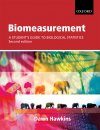![Biomeasurement: Understanding, Analysing and Communicating Data in the Biosciences Biomeasurement: Understanding, Analysing and Communicating Data in the Biosciences]()
Click to have a closer look
About this book
Contents
Related titles
Recommended titles
About this book
Biomeasurement offers a refreshing, student-focused introduction to the use of statistics in the study of the biosciences. Emphasising why statistical techniques are essential tools for bioscientists, the book removes the stigma attached to statistics by giving students the confidence to use key techniques for themselves.
Contents
CHAPTER 1: WHY AM I READING THIS BOOK?; 1.1 My lecturer is a sadist!; 1.2 Doing science: the big picture; 1.3 The process in practice; 1.4 Essential skills for doing science; 1.5 Types of data analysis; CHAPTER 2: GETTING TO GRIPS WITH THE BASICS; 2.1 Populations and samples; 2.2 Variation and variables; 2.3 Understanding data; 2.4 Demystifying formulae; CHAPTER 3: DESCRIBING A SINGLE SAMPLE; 3.1 The single sample; 3.2 Descriptive statistics; 3.3 Frequency distributions; 3.4 Pies, boxes, and errors; 3.5 Example data: ranger patrol tusk records; 3.6 Worked example: using SPSS; CHAPTER 4: INFERRING AND ESTIMATING; 4.1 Overview of inferential statistics; 4.2 Inferring through estimation; 4.3 Exampledata: ground squirrels; 4.4 Worked example: using SPSS; CHAPTER 5: OVERVIEW OF HYPOTHESIS TESTING; 5.1 Four steps of (statistical) hypothesis testing; 5.2 Error and power; 5.3 Parametric and nonparametric; 5.4 One-and two-tailed tests; CHAPTER 6: TESTS ON FREQUENCIES; 6.1 Introduction to chi-square tests; 6.2 Example data; 6.3 One-way classification chi-square test; 6.4 Two-way classification chi-square test; CHAPTER 7: TESTS OF DIFFERENCE: TWO UNRELATED SAMPLES; 7.1 Introduction to the t-and Mann-Whitney U tests; 7.2 Example data: dem bones; 7.3 t-Test; 7.4 Mann-Whitney U test; CHAPTER 8: TESTS OF DIFFERENCE: TWO RELATED SAMPLES; 8.1 Introduction to paired t- and Wilcoxon signed- rank tests; 8.2 Example data: big horn ewes; 8.3 Paired t-test; 8.4 Wilcoxon signed-rank test; CHAPTER 9: TESTS OF DIFFERENCE: MORE THAN TWO SAMPLES; 9.1 Introduction to one-way and Kruskal-Wallis Anov atests; 9.2 Example data: nitrogen levels in reeds; 9.3 One-way Anova test; 9.4 Two-way Anova test; 9.5 Kruskal-Wallis test; 9.6 Model I and model II Anova; CHAPTER 10: TESTS OF RELATIONSHIP: REGRESSION; 10.1 Introduction; 10.2 Example data: species richness; 10.3 Regression test; 10.4 Logistic regression; 10.5 Multiple regression; 10.6 Model I and model II regression; CHAPTER 11: TESTS OF RELATIONSHIP: CORRELATION; 11.1 Introduction to the Pearson and Spearman correlation tests; 11.2 Example data: eyeballs; 11.3 Pearson correlation test; 11.4 Spearman correlation test; 11.5 Comparison of correlation and regression; CHAPTER 12: INTRODUCING TH GENERAL LINEAR MODEL; 12.1 Introduction to General Linear Model; 12.2 Example data: watered willow; 12.3 Testing using the General Linear Model; 12.4 Interaction; 12.5 Random factors and mixed models; 12.6 Types of sums of squares; 12.7 Getting the most out of GLM: Multiple models and model choice; 12.8 The general and generalized linear models compared; CHAPTER 13: CHOOSING THE RIGHT TEST AND GRAPH; 13.1 Introduction to choosing; 13.2 Which test?; 13.3 Which graph?; 13.4 Worked examples: graphs using SPSS; 13.5 How to report your results
Customer Reviews




































